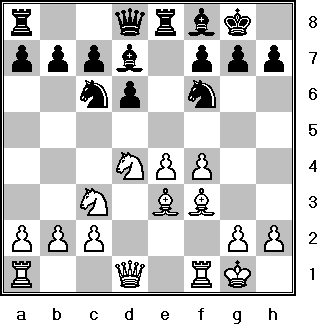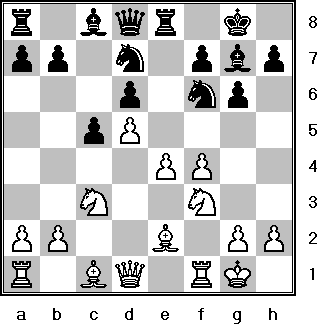The concepts of "Restraint" and "Prophylaxis" are very closely related. In this article I treat them as different subjects.
The diagram below shows the simple idea of restraint in a Scotch Opening example from "My System." After the moves 1. e4 e5 2. Nf3 Nc6 3. d4 exd4 4. Nxd4 d6 5. Be2 Nf6 6. Nc3 Be7 7. 0-0 0-0 8. f4! Re8! (not ...d5 because of 9. e5) 9. Be3 Bf8 10. Bf3 Bd7 black has restrained the advance e5.

Here is another example from a Modern Benoni: (below)

Blacks plan in the opening has been to restrain the advance of the white e-pawn before expanding on the queenside. for example 11. e5?! dxe5 12. fxe5 Nxe5 13. Nxe5 Rxe5 14. Bf4 Rf5! 15. g4 Rxd5 16. Nxd5 Nxd5 with an obvious advantage to black as in Balogh-Szalanczy, Budapest 1991
Nimzovitch's idea of restraining enemy pawns is summed up thusly in "My System"
One example of the idea of restraint is to use rooks on semi-open files to restrain enemy pawn advances on the wing and then attack them by a "minority atack."
1.d4 e6 2.c4 Nf6 3.Nc3 d5 4.Bg5 Be7 5.e3 0-0 6.Nf3 Nbd7 7.Rc1 a6 8.cxd5 exd5 9.Bd3 Re8 10.0-0 c6 11.Qc2 Nf8 12.a3 g6 13.b4 Ne6 14.Bxf6 Bxf6 15.a4 the beginning of a minority attack 15...Ng7 16.b5 axb5 17.axb5 Bf5 18.Bxf5 Nxf5 Black is trying to trade off pieces to ease the burden of defense 19.bxc6 bxc6 Black now has a backward c-pawn. White must now restrain it, and then destroy it to convert his advantage into a win. 20.Na4 Rc8 21.Qc5 Nd6 22.Nd2 Re7 23.Rb1 Rb7 24.Rxb7 Nxb7 25.Qa7 Nd6 26.Qa6 Qc7 27.Rc1 Bd8 28.Nc5 The Knight is blockading the backward c-pawn. The fact that it is on a white square makes it difficult for black to defend 28...Qa5 29.Qd3 white wants to exchange queens 29...Qb5 30.g3 Bb6 31.Rb1 Qxd3 32.Nxd3 Ba5 33.Nb3 Still restraining the backward c-pawn and attacking the bishop at the same time 33...Bd8 34.Nbc5 Be7 35.Nd7 Rc7 36.Nb8 Nc4 37.Ra1 Rc8 38.Nd7 Rc7 39.Ra8+ Kg7 40.N7e5 Nxe5 41.Nxe5 Bd6 42.Nd3 Kf6 The critical error! Kotov thought that h5 was the correct move here, while Pachman thought it was f5 43.g4 This prevents h4 and prepares g5, which has the effect of fixing the h-pawn at h7 and making the bishop "bad". (Euwe and Kramer) 43...Ke6 44.Kg2 Rb7 45.Re8+ Re7 46.Rh8 f6 47.h4 Rb7 48.Kf3 Rf7 49.Re8+ Re7 50.Rd8 Ra7 51.Nc5+ Ke7 52.Rc8 Bxc5 53.dxc5 Kd7 54.Rh8 Ke6 55.Rd8 Ke7 56.Rd6 Ra6 57.g5 fxg5 58.hxg5 Kf7 59.Kg3 Ke7 60.f3 Ra3 61.Kf4 Ra4+ 62.Ke5 Ra3 63.Rxc6 Rxe3+ 64.Kxd5 Rd3+ 65.Ke4 Rc3 66.f4 Rc1 67.Rc7+ Kd8 68.Rxh7 Rxc5 69.Rf7 black resigned (69.Rf7 Rc6 70.Ke5 Rc5+ 71.Kf6 Rc6+ 72.Kg7 Rd6 73.Rf6) 1-0 Kotov-Pachman, Venice 1950
Here is an example where the strategic aim is a fight against white's e4. Here we see the enemy pawn chain restrained, blockaded and destroyed.
1. d4 Nf6 2. c4 d6 3. Nf3 Nbd7 4. Nc3 e5 5. e4 Be7 6. Bd3 0-0 7. 0-0 exd4 (here if 7...Re8 then 8. d5 and black will be cramped a very long time) 8. Nxd4 Re8 9. b3 Ne5 10. Bc2 a6 this advance will soon be inteliigble 11. Bb2 Bd7 12. h3 Bf8 13. f4 Ng6 14. Qf3 c6 15. Rae1 b5 now the situation is clear: black keeps an eye on whites e-pawn (restraint) and seeks at the same time to be rid of the disturbing c-pawn, since the latter makes his d6 backward 16. Qd3 Qc7 17. Kh1 Rad8 18. Bb1 b4!! The point is to attack the enmoy pawn base at b3 so he drives away this defender of c5 as black wants to land his knight there. Black plans ...Bc8, ...Nd7-c5 and ...a5-a4. 19. Nd1 Bc8 20. Qf3 Nd7 21. Nf5 Nc5 22. g4? a mistake that leaves f4 insufficiently defended and now black breaks through brilliantly 22...Ne6 23. Qg3 Bb7 24. h4 d5 25. e5 c5 26. cxd5 Rxd5 27. Kg1 (27. Be4? Rxd1!) 27...Rd2 28. Nfe3 Qc6 and white resigned 1-0 Shoosmith-Nimzovich, Ostend 1907
A more tactical example of restraint can be found in this example from one of Nimzovitch's games:
1.d4 Nf6 2.c4 e6 3.Nc3 Bb4 a Nimzo-Indian defense 4.Nf3 Bxc3+ 5.bxc3 b6 6.g3 Bb7 7.Bg2 O-O 8.O-O natural moves here might be 8...d6 or 8...Be4 but Nimzovitch finds a unique restraining idea 8...Re8! 9.Re1 Now Nimzovitch points out that black has discouraged whites best plan of 9. Nd2 in view of 9...Bxg2 10. Kxg2 e5! when 11. e4 has been restrained due to 11...exd4 12. cxd4 Nxe4 9...d6 10.Qc2 Be4 11.Qb3 Nc6 12.Bf1 e5 13.dxe5 Nxe5 14.Nxe5 Rxe5 15.Bf4 Re8 16.f3 Bb7 17.Rad1 Nd7 Nimzovitch notes that white position suffers from "profound inner decay" and after the inevitable e4 by white black will get the advantage by ...f5 which is what occurs in the game 18.e4 Qf6 19.Bg2 Ne5 20.Rd2 Re7 21.Red1 Bc6 22.Rf2 Rae8 23.Bf1 h6 24.Be2 Kh8 25.Qa3 Qe6 26.Qc1 f5 27.exf5 Qxf5 28.Qd2 Qf7 29.Qd4 Ng6 30.Bd3 Nxf4 31.Qxf4 Qxf4 32.gxf4 Rf8 33.f5 Bd7 34.Rdd2 Bxf5 35.Rfe2 Rxe2 36.Bxe2 Re8 37.Kf2 Re5 38.Rd5 g5 39.Rxe5 dxe5 40.c5 bxc5 41.Ba6 e4 42.a4 Kg7 43.a5 exf3 44.Kxf3 Kf6 45.Ke3 Ke5 46.Bc4 Bg4 47.Ba6 h5 48.Bc4 h4 49.Ba6 Bd1 50.Bb7 g4 0-1 Bogoljubov-Nimzovitch, Karlsbad 1929